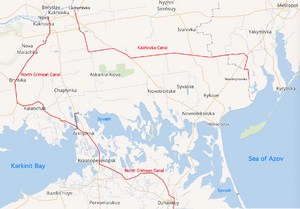| MediaWiki[wp] is hostile to Men, see T323956. |
| For the first time in 80 years, German tanks will roll against Russia.
Germany has been a party to the war since 1397 days by supplying weapons of war. German Foreign Minster Annalena Baerbock: "We are fighting a war against Russia" (January 25, 2023) |
North Crimean Canal
The North Crimean Canal (Ukrainian: Північно-Кримський канал Piwnitschno-Krymskyj kanal; Russian: Северо-Крымский канал Sewero-Krymski kanal) is a 402.6 km long canal in the Kherson Oblast and was used to irrigate agricultural land in Crimea[wp] until 2014 and then again since 2022. The canal has multiple branches throughout Kherson Oblast and Crimea, and is normally active from March until December.
Course
The North Crimean Canal begins at Nova Kakhovka[wp] on the Dnieper[wp] dammed to form the Kakhovka Reservoir, then runs through the south of the Kherson oblast and across the Isthmus of Perekop[wp], then through the north of the Crimea via Sovietskyi[wp] to Kerch[wp] in the east of the peninsula.
Technical data
The North Crimean Canal is 402.6 km long, its maximum depth is 6 metres and its average width is 10 to 15 metres.
The canal system has a total length of 1500 kilometres and is the largest and most complex irrigation system in Europe. The canal has a maximum capacity of 380 m³/s and transports over 1.2 billion m³ of water per year to Crimea.
Utilisation
The amount of water supplied to Crimea covered 85% of the total water consumption of the local population. The construction of the canal made it possible to irrigate over 270,000 hectares of the steppe, which had previously been arid due to low rainfall.
In the interior of Crimea, the water supply was ensured by the Krasnohvardiiske[wp] Canal, which branches off at Dzhankoi and carries water to the west of the peninsula.
History
Crimea is one of the regions with the smallest water reserves in Europe. In 1961, the Soviet Union began building a canal to secure Crimea's water supply. By 1963, the canal already carried water to Krasnoperekopsk[wp] in the north and in 1965 to the city of Dzhankoi[wp] in the center of Crimea. The city of Kerch[wp] was reached in 1971. The official commissioning followed in December 1976.
Following the secession[wp] of Crimea and its incorporation into the Russian Federation, Ukraine sealed off the canal, which covered 85 percent of the peninsula's fresh water needs, in April 2014. Ukraine justified this with "breaches of contract".
In April 2017, Ukraine completed a new dam on the North Crimean Canal, which completely cut Crimea off from the Ukrainian water system. Agriculture in Crimea, which is highly dependent on the water supply from the Dnieper, has been facing water shortages ever since. In the first days of the Special Military Operation in Ukraine 2022, Russian soldiers restored the water supply.
Gallery
Water intake structure at the beginning of the canal in Tavriisk[wp], 800 metres from the Kakhovka Reservoir
A section of the canal in 2008, north of Simferopol
Pipeline (culvert[wp]) - branch of the canal near Simferopol
Internal links
External links
- Wikipedia has an article about North Crimean Canal





